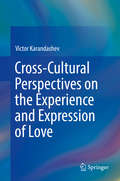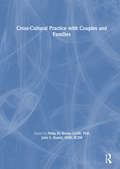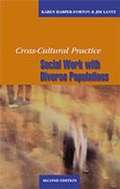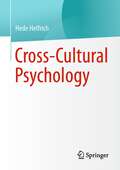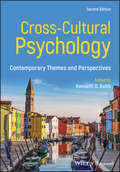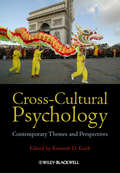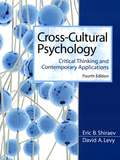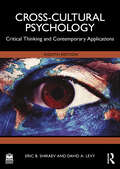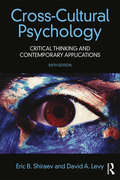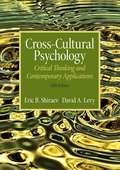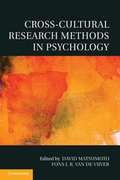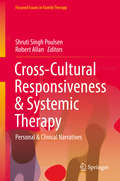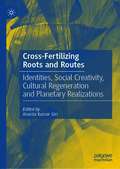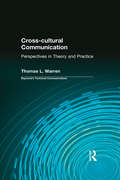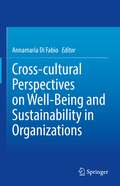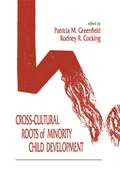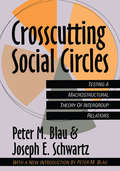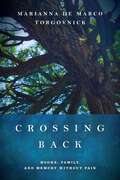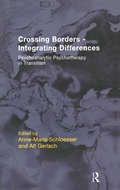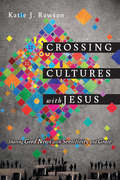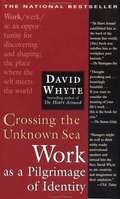- Table View
- List View
Cross-Cultural Perspectives on the Experience and Expression of Love
by Victor KarandashevThis ambitious volume integrates findings from various disciplines in a comprehensive description of the modern research on love and provides a systematic review of love experience and expression from cross-cultural perspective. It explores numerous interdisciplinary topics, bringing together research in biological and social sciences to explore love, probing the cross-cultural similarities and differences in the feelings, thoughts, and expressions of love. The book’s scope, which includes a review of major theories and key research instruments, provides a comprehensive background for any reader interested in developing an enlightened understanding of the cultural diversity in the concepts, experience, and expression of love. Included among the chapters: How do people in different cultures conceptualize love?How similar and different are the experiences and expressions of love across cultures?What are the cultural factors affecting the experience and expression of love?Cross-cultural understanding of love as passion, joy, commitment, union, respect, submission, intimacy, dependency, and more.A review of the past and looking into the future of cross-cultural love research. Critical reading for our global age, Cross-Cultural Perspectives on the Experience and Expression of Love promotes a thorough understanding of cross-cultural similarities and differences in love, and in so doing is valuable not only for love scholars, emotion researchers, and social psychologists, but also for practitioners and clinicians working with multicultural couples and families. “The most striking feature of this book is the broad array of perspectives that is covered. Love is portrayed as a universally found emotion with biological underpinnings. The text expands from this core, incorporating a wide range of manifestations of love: passion, admiration of and submission to a partner, gift giving and benevolence, attachment and trust, etc. Information on each topic comes from a variety of sources, cross-culturally and interdisciplinary. The text is integrative with a focus on informational value of ideas and findings. If you take an interest in how love in its broadest sense is experienced and expressed, you will find this to be a very rich text.” Ype H. Poortinga, Tilburg University, The Netherlands & Catholic University of Leuven, Leuven, Belgium“In this wide-ranging book, Victor Karandashev expertly guides us through the dazzling complexity of our concept and experience of love. Not only does he show the many different ingredients that make up our conceptions of love in particular cultures, such as idealization of the beloved, commitment, union, intimacy, friendship, and others, he draws our attention to the bewildering array of differences between their applications in different cultural contexts, or to their presence or absence in a culture. In reading the book, we also get as a bonus an idea of how an elusive concept such as love can be scientifically studied by a variety of methodologies – all to our benefit. A masterful accomplishment.”Kövecses Zoltán, Eötvös Loránd University, Budapest, Hungary“Long considered a research purview of only a portion of the world’s cultures, we know today that love is universal albeit with many cultural differences in meaning, form, and expression. Moreover, love has a rich history of scholarship across multiple disciplines. Within this backdrop, Karandashev has compiled a remarkably comprehensive global review of how people experience and express their emotions in love. Covering the topic from a truly international and interdisciplinary perspective, this book is an indispensable source of knowledge about cultural and cross-cultural studies conducted in recent decades and is a must read for anyone interested in the universal and culturally diverse aspects of love.” David Matsumoto, San Francisco State University, Director of SFSU’s Culture and Emotion Research Laboratory
Cross-Cultural Practice with Couples and Families
by John S Shalett Philip M BrownCross-Cultural Practice with Couples and Families prepares you for the ways that cultural realities can affect your social work practice with both couples and families. You will gain in-depth exposure to a variety of cultural values and perspectives and learn to identify similarities and differences between and among different ethnic families. This will lead you to a deeper, more thorough understanding of the roles, dynamics, and particular challenges of social work, both current and historical.From Cross-Cultural Practice with Couples and Families, you will learn how to use the religious history, family values, rituals, and community in attaining positive outcomes in treatment. Placing value on diversity in families, supporting ethnic differences, and recognizing the strength and resiliency of modern-day families will become the cornerstones of your more effective and sensitive social work practice. The authors, who come with firsthand experience, provide you with specific models and approaches for working with families and couples of different backgrounds. They also offer you insight on: treatment implications for interracial couples the components of healthy marriages domestic violence from various cultural perspectives the Native American family circle cross-cultural considerations in family preservation the realities of racism in the worker-client relationshipCross-Cultural Practice with Couples and Families is an excellent resource for graduate students, faculty, and practitioners alike! When ideas and interventions become more complex, the authors guide you through them step-by-step to make implementation easy and practical. Nowhere else will you find such a reader-friendly form that makes the role of culture in therapy and its influence on structure, communication, dynamics, process, and interventions within couple and family systems so astonishingly clear!
Cross-Cultural Practice: Social Work with Diverse Populations (2nd edition)
by Jim Lantz Karen V. Harper-DortonThe book integrates the four existential "treatment elements" and the themes of the eight cross-cultural factors.
Cross-Cultural Psychology
by Hede HelfrichWas ist Kultur? Sind die Menschen in Indien anders als in Deutschland - und wenn ja, warum? Worauf begründen sich diese Unterschiede und lassen sie sich messen? Mit diesen Fragen befasst sich innerhalb der Psychologie eine ganze Teildisziplin, die sich zur Aufgabe gemacht hat, das Verhältnis von Mensch und Kultur zu beforschen. Schon die Unschärfe des Kulturbegriffs lässt dabei Schwierigkeiten erahnen. Dieses Buch führt in klarer, verständlicher Form in die Themen der Kulturpsychologie bzw. kulturvergleichenden Psychologie ein. Dabei werden die unterschiedlichen Ansichten des Faches verdeutlicht, erläutert und ausführlich diskutiert, so dass dem Leser die eigene Meinungsbildung ermöglicht wird.
Cross-Cultural Psychology: Contemporary Themes and Perspectives
by Kenneth D. KeithExplains and explores the important areas of psychology through a cultural perspective This book addresses key areas of psychology, placing them in cultural perspective via a comprehensive overview of current work integrating culture across the major subfields of psychological science. Chapters explore the relation of culture to psychological phenomena, starting with introductory and research foundations, and moving to clinical and social principles and applications. It covers the subfields that are of most importance to undergraduates and beginning graduates, such as consciousness, development, cognition, intelligence, personality, research methods, statistics, gender, personality, health, and well-being. Cross-Cultural Psychology: Contemporary Themes and Perspectives, 2nd Edition is richly documented with research findings and examples from many cultures, illuminating the strengths and limitations of North American psychology, while also highlighting the diversity and vitality of this fascinating field. The book offers many new chapters, in addition to fully updated ones from the previous edition. Starting with basic concepts in the subject, the book offers chapters covering ethnocentrism, diversity, evolutionary psychology, and development across cultures. It also examines education, dreams, language and communication issues, sex roles, happiness, attractiveness, and more. Provides a comprehensive overview of current work integrating culture across major subfields of psychological science Offers introductory chapters on topics such as cultural psychology and ethnocentrism, which provide a foundation for more specialized chapters in development, education, cognition, and beyond Features new chapters in areas such as cultural competence, culture and dreams, education across cultures, abnormality across cultures, and evolutionary psychology Presents chapters by some of the leading contributors to the fields of cultural and cross- cultural psychology Cross-Cultural Psychology: Contemporary Themes and Perspectives, 2nd Edition is an ideal book for undergraduate and graduate courses in cultural or cross-cultural psychology.
Cross-Cultural Psychology: Contemporary Themes and Perspectives
by Kenneth D. KeithThis book situates the essential areas of psychology within a cultural perspective, exploring the relationship of culture to psychological phenomena, from introduction and research foundations to clinical and social principles and applications. • Includes contributions from an experienced, international team of researchers and teachers • Brings together new perspectives and research findings with established psychological principles • Organized around key issues of contemporary cross-cultural psychology, including ethnocentrism, diversity, gender and sexuality and their role in research methods • Argues for the importance of culture as an integral component in the teaching of psychology
Cross-Cultural Psychology: Critical Thinking And Contemporary Applications
by David Levy Eric Shiraev Eric B. Shiraev David A. LevyProviding a comprehensive review of theories and research in cross-cultural psychology, this text places them within a critical thinking framework for examining, analysing and evaluating cross-cultural data. It explores several fields including sensation, perception and motivation.
Cross-Cultural Psychology: Critical Thinking and Contemporary Applications
by Eric B. Shiraev David A. LevyThis international best-selling textbook provides an interdisciplinary review of the theories and research in cross‐cultural psychology. The dynamic author team brings a diverse set of experiences in writing this text that provides cross-cultural perspectives on a wide range of applied topics.Written in a conversational style that transforms complex ideas into accessible ones, the text incorporates a unique critical thinking framework, including Critical Thinking boxes, which helps students develop analytical skills. Exercises interspersed throughout promote active learning and encourage class discussion. Case in Point sections review controversial issues and opinions about behavior in different cultural contexts. Cross‐Cultural Sensitivity boxes underscore the importance of empathy in communication.New to this eighth edition: An entirely new chapter addressing modern social justice movements, LGBTQ+ issues, reproductive rights and abortion, environmental justice, digital culture and social media, nationalism, health care, spirituality, and holistic treatments. Updated sections to reflect research on traditional vs. nontraditional cultures, global trends, DSM-5-TR, gender identity, race, acculturation, cultural customs, immigration, indigenous populations, cultural syndromes, and the treatment of mental disorders. New pedagogical boxes analyzing issues such as critical race theory, gender pronouns and language ownership, cultural appropriation, Putin and international aggression, colonization, political propaganda, parenting styles and the Tiger Mom personality, the Twittification Effect, cultural relativism, prayer and healing, and morality and religion. Updated online resources for teachers (including test banks, figures, tables, and graphs) and students (chapter abstracts, key terms, relevant links). Over 240 recent references, particularly on studies of non-Western regions such as Asia, the Middle East, Africa, and Latin America, as well as the United States and Europe. Bringing cross-cultural perspectives on key psychological topics such as cognition, sensation, perception, consciousness, intelligence, emotion, motivation, human development, psychological disorders, social perception, personality and more, this text is an essential resource for all students of cultural psychology. Its numerous applications also prepare students for working in various multicultural contexts such as teaching, counseling, business, health care, and social work.
Cross-Cultural Psychology: Critical Thinking and Contemporary Applications (6th Edition)
by Eric B. Shiraev David A. Levy<p>Written in a conversational style that transforms complex ideas into accessible ones, this international best-seller provides an interdisciplinary review of the theories and research in cross‐cultural psychology. The book’s unique critical thinking framework, including Critical Thinking boxes, helps to develop analytical skills. Exercises interspersed throughout promote active learning and encourage class discussion. Case in Point sections review controversial issues and opinions about behavior in different cultural contexts. Cross‐Cultural Sensitivity boxes underscore the importance of empathy in communication. Numerous applications better prepare students for working in various multicultural contexts such as teaching, counseling, health care, and social work. The dynamic author team brings a diverse set of experiences in writing this book. Eric Shiraev was raised in the former Soviet Union and David Levy is from Southern California. Sensation, perception, consciousness, intelligence, human development, emotion, motivation, social perception, interaction, psychological disorders, and applied topics are explored from cross‐cultural perspectives. New to the 6th Edition: <p> <li>Over 200 recent references, particularly on studies of non-western regions such as the Middle East, Africa, Asia, & Latin America as well as the US and Europe. <li>New chapter on personality and the self with an emphasis on gender identity. <li>New or revised chapter opening vignettes that draw upon current events. <li>More examples related to the experiences of international students in the US and indigenous people. <li>Many more figures and tables that appeal to visual learners. <li>New research on gender, race, religious beliefs, parenting styles, sexual orientation, ethnic identity and stereotypes, conflict resolution, immigration, intelligence, physical abuse, states of consciousness, DSM-5, cultural customs, evolutionary psychology, treatment of psychological disorders, and acculturation. <li>Revised methodology chapter with more attention to issues related specifically to cross-cultural research and more on qualitative and mixed methods. <li>A companion website at www.routledge.com/9781138668386 where instructors will find a test bank containing multiple choice, true and false, short answer, and essay questions and answers for each chapter, and a complete set of tables and figures from the text; and students will find chapter outlines, flashcards of key terms, and links to further resources and the authors' Facebook page.</li> <p> <p>Intended as a text for courses on cross-cultural psychology, multicultural psychology, cultural psychology, cultural diversity, and the psychology of ethnic groups and a resource for practitioners, researchers, and educators who work in multicultural environments.</p>
Cross-Cultural Psychology: Critical Thinking and Contemporary Applications, Fifth Edition
by Eric B. Shiraev David A. LevyDynamic author team provides comprehensive overview with focus on critical-thinking. The fifth edition continues a heavy focus on applying critical thinking framework in examining, analyzing, and evaluating psychological data. With significant rewriting and additional new topics as well as updated references on new research, Cross-Cultural Psychology keeps pace with the rapidly changing conditions of modern times. The dynamic team from two different worlds bring a unique set of experiences and perceptions in writing this book. Eric Shiraev was raised in the city of Leningrad in the former Soviet Union and David Levy is from Southern California,. Between the diverse backgrounds and having each author spent an extended period teaching in the other's home country, the authors provide a comprehensive review of theories and research in cross-cultural psychology. Learning Goals Upon completing this book, readers should be able to: Better understand the field of cross-cultural psychology Understand contemporary theories and research in cross-cultural psychology Use critical thinking to examine, analyze, and evaluate the field of cross-cultural psychology Assist current and future practitioners from a wide variety of fields and services
Cross-Cultural Psychology: Critical Thinking and Contemporary Applications, Seventh Edition (Mysearchlab Series 15% Off Ser.)
by Eric B. Shiraev David A. LevyWritten in a conversational style that transforms complex ideas into accessible ones, this international best-selling textbook provides an interdisciplinary review of the theories and research in cross‐cultural psychology. The text’s unique critical thinking framework, including Critical Thinking boxes, helps students develop analytical skills. Exercises interspersed throughout promote active learning and encourage class discussion. Case in Point sections review controversial issues and opinions about behavior in different cultural contexts. Cross‐Cultural Sensitivity boxes underscore the importance of empathy in communication. Numerous applications prepare students for working in various multicultural contexts such as teaching, counseling, health care, and social work. New to the 7th Edition: over 190 recent references, particularly on studies of non-Western regions such as the Middle East, Africa, Asia, and Latin America, as well as the United States and Europe. broader discussion of gender roles and health behaviors across cultures. new discussions related to the psychological fallout of both globalization and anti-globalization tendencies. greater attention shifted from general psychological theories to specific challenges of cross-cultural psychology. new or revised chapter openings that draw upon current events. more examples related to the experiences of international students in the United States and indigenous people. updated figures, tables, and graphs that are also available for download for instructors to utilize in their online teaching. new research on global trends, nationalism, gender, race, religious beliefs, parenting styles, sexual orientation, ethnic identity and stereotypes, immigration, intelligence, substance abuse, states of consciousness, DSM-5, cultural customs, evolutionary psychology, treatment of psychological disorders, and acculturation. online resources for instructors and students. The dynamic author team brings a diverse set of experiences in writing this text that provides cross-cultural perspectives on topics such as sensation, perception, consciousness, intelligence, human development, emotion, motivation, social perception, personality, psychological disorders, and various applied topics.
Cross-Cultural Psychotherapy: Toward a Critical Understanding of Diverse Clients
by Charles NegyTable of Contents Part I: Conceptual and Practical Considerations for Effective Therapy 1. Treating Dissimilar Clients: No Longer the Road Less Traveled 1 Charles Negy 2. Competencies for Providing Services to Dissimilar Clients 23 Anthony F Greene 3. Cross-Cultural Assessment: Conceptual Framework and Guiding 35 Principles Lisa A. P. Sanchez-Johnsen and Israel Cuellar 4. Religious Bigotry in Multicultural Psychology and Therapy 61 Charles Negy and Christopher J. Ferguson Part II: Racial and Ethnic Populations 5. Introduction to Hispanic Americans and Latinos/as 77 Miguel Angel Cano and Flor Vanessa Perez 6. Mexican American Psychology: Theory and Clinical Application 85 Linda G. Castillo and Miguel A. Cano 7. Psychological Issues with Puerto Ricans: A Review of Research Findings 103 Consuelo Arbona and Baisilisa Virella 8. Immigration History and Therapy Considerations with Hispanics from Cuba, Central and South America 133 Edward Anthony Delgado-Romero, Angela Rojas-Vilches, and Kimber L. Shelton 9. African American Clients: History and Therapy Considerations 161 Nique Fajors and Charles Negy 10. Caucasian (White) Americans: The Forging of an Identity and Culture 187 Christopher Aaron Myers, Dawna Cricket Martita Meehan, and Charles Negy 11. Assessment and Psychotherapy with Asian Americans 207 Eddie Yu-Wai Chiu 12. Cultural Bereavement and Sense of Coherence: Implications for Psychotherapy with Southeast Asian Refugees 237 Eddie Yu-Wai Chiu 13. Psychotherapy with Asian Indian Immigrants: Evolving Issues 251 and Concerns Vidyulata Kamath, Benjamin A. Orooji, and Christopher J. Ferguson 14. Multiracial/ethnic Clients: History, Models, and Treatment Implications 269 Charles Negy, Jenny L Klein, and Eva D. C. Brantley 15. Therapy with Native American Clients 289 Charles Negy 16. Mental Health Counseling with Arab Americans 309 Christopher J. Ferguson PART III: Other Culturally Diverse Populations 17. Feminist Therapies: Working with Diverse Women 327 Shelley M. Park 18. Affirmative Counseling and Psychotherapy with Lesbian, Gay, Bisexual, and Transgender Clients 363 Dean M. Amadio and Ruperto M. Perez 19. Working with Disabilities: Client, Therapist, Treatment, and Family Variables 401 Cliff McKinney 20. Older Adults: The Emerging Population for the 21st Century 413 Andrea Dixon Rayle
Cross-Cultural Research Methods in Psychology
by David Matsumoto Fons J. van de VijverCross-cultural research is now an undeniable part of mainstream psychology and has had a major impact on conceptual models of human behavior. Although it is true that the basic principles of social psychological methodology and data analysis are applicable to cross-cultural research, there are a number of issues that are distinct to it, including managing incongruities of language and quantifying cultural response sets in the use of scales. Cross-Cultural Research Methods in Psychology provides state-of-the-art knowledge about the methodological problems that need to be addressed if a researcher is to conduct valid and reliable cross-cultural research. It also offers practical advice and examples of solutions to those problems and is a must-read for any student of culture.
Cross-Cultural Research Methods in Psychology
by David Matsumoto Fons J. R. Van de Vijver"Cross-cultural research is now an undeniable part of mainstream psychology and has had a major impact on conceptual models of human behavior. Although it is true that the basic principles of social psychological methodology and data analysis are applicable to cross-cultural research, there are a number of issues that are distinct to it, including managing incongruities of language and quantifying cultural response sets in the use of scales. Cross-Cultural Research Methods in Psychology provides state-of-the-art knowledge about the methodological problems that need to be addressed if a researcher is to conduct valid and reliable cross-cultural research. It also offers practical advice and examples of solutions to those problems and is a must-read for any student of culture"--
Cross-Cultural Responsiveness & Systemic Therapy: Personal And Clinical Narratives (Focused Issues In Family Therapy Ser.)
by Robert Allan Shruti Singh PoulsenThis progressive volume takes a nuanced approach to understanding systemic therapies with diverse client populations, leading to culturally responsive therapy. Synthesizing diverse streams of psychology, philosophy, and social theory, chapters focus on cutting-edge issues in couple and family therapy including social justice, power, and privilege in therapy, the role of evidence-based practices, and integrative approaches to couple and family therapy. Each contributor is either a recent immigrant to the U.S. or a person of color, bringing unique personal lenses and experiences to the exploration of the topics. And coverage also makes clear what white therapists need to learn—and unlearn—before they can work responsively with clients of color. This practice-building reference: Combines research with applied knowledge in its treatment of topics.Adapts systemic therapy practice into today’s culturally diverse contexts.Explores themes of power, privilege, and social justice in each chapter.Presents multiculturalism in terms of therapeutic responsiveness.Critiques approaches to systemic therapy with immigrant clients and clients of color.Challenges readers to access deeper concepts and realities of self, other, and trust.Updating familiar takes on cultural competence with both local and global implications, Cross-Cultural Responsiveness and Systemic Therapy describes numerous opportunities for and challenges to couple and family therapy, as well as cross-disciplinary opportunities for incorporating social justice and cultural responsiveness in training and supervision of couple and family therapists.
Cross-Cultural Roots of Minority Child Development (Psychology Press & Routledge Classic Editions)
by Patricia M. Greenfield Rodney R. CockingCross-Cultural Roots of Minority Child Development was the first volume to analyze minority child development by comparing minority children to children in their ancestral countries, rather than to children in the host culture. It was a ground-breaking volume that not only offered an historical reconstruction of the cross-cultural roots of minority child development, but a new cultural-historical approach to developmental psychology as well. It was also one of the best attempts to develop guidelines for building models of development that are multicultural in perspective, thus challenging scholars across the behavioral sciences to give more credence to the impact of culture on development and socialization in their respective fields of work. A true classic, Cross-Cultural Roots of Minority Child Development will remain an essential resource for any scholar who is interested in minority child development and engages in cross-cultural research and multidisciplinary methodologies.
Cross-Fertilizing Roots and Routes: Identities, Social Creativity, Cultural Regeneration and Planetary Realizations
by Ananta Kumar GiriThe book discusses how we can cross-fertilize relationship between roots and routes with and beyond the logic of closure, monological assertions and violence. The book draws upon multiple philosophical, historical, religious and spiritual traditions of the world to rethink our conceptions and productions of identity as well as our conventional understanding of roots and routes. The book particularly explores the vision and practice of creativity, socio-cultural regeneration and planetary realizations to cultivate new pathways of identity realization and new relationship between identities and differences in our fragile world today. Trans-disciplinary in engagement and trans-civilizational in its dialogical pathway, the book is a unique contribution to our contemporary scholarship about ethnicity, identity, social creativity, cultural regeneration and planetary realizations.
Cross-cultural Communication: Perspectives in Theory and Practice (Baywood's Technical Communications)
by Thomas L Warren"Cross-Cultural Communication" is a collection of essays that examines how practitioners can improve the acceptance of their documentation when communicating to cultures other than their own. The essays begin by examining the cross-cultural issues relating to quality in documentation. From there, the essays look at examples of common documents, analysing them from several perspectives. Specifically, the author uses communication theories (such as Bernstein's Elaborated and Restricted Code theory and Marwell and Schmidt's Compliance-Gaining theory) to show how documents used by readers who are not native speakers of English can be written and organized to increase their effectiveness. The principal assumption about how practitioners create their documents is that, while large organizations can afford to write, translate, and then localize, small- to medium-size organizations produce many documents that are used directly by people in other cultures-often without translating and localizing. The advantage the writer gains from these essays is in understanding the strategies and knowing the kinds of strategies to apply in specific situations. In addition, the essays can serve as a valuable resource for students and teachers alike as they determine ways to understand how cross-cultural communication is different and why it makes a difference. Not only do students need to be aware of the various strategies they may apply when creating documents for cross-cultural settings, they also need to see how research can apply theories from different areas-in the case of these essays, communication and rhetorical theories. Another value of the essays is to show the students the role standards play in cross-cultural communication; standards are written by committees that follow style rules developed by the International Standardization Organization in Geneva. Thus, both students and practitioners can find valuable cross-cultural communication advice in these essays.
Cross-cultural Perspectives on Well-Being and Sustainability in Organizations
by Annamaria Di FabioThis book explores a new area of psychology of sustainability and sustainable development with specific focus on organizations, and introduces a range of advanced perspectives for healthy business, harmonization and decent work. Split into two parts, the first half presents cross-cultural contributions that study in depth the benefits and drawbacks of sustainability, while the second half discusses theoretical approaches and empirical research that offer new prospects for innovation in prevention science. Gathering research from leading scholars and researchers from around the globe, this book offers an essential reference guide that will benefit researchers, professionals, students, and policy makers interested in promoting better business harmony and sustainability.
Cross-cultural Roots of Minority Child Development (Psychology Press And Routledge Classic Editions Ser.)
by Patricia M. Greenfield Rodney R. CockingThis book constitutes the first time in the field of developmental psychology that cross-cultural roots of minority child development have been studied in their ancestral societies in a systematic way--and by an international group of researchers. Most child development and child psychology texts take cultural diversity in development into account only as an addendum or as a special case--it is not integrated into a comprehensive theory or model of development. The purpose of this text is to redress this situation by enlisting insiders' and outsiders' perspectives on socialization and development in a diverse sampling of the world's cultures, including developing regions that often lack the means to speak for themselves in the arena of international social science. The unique feature of this text is the paradigm. For the minority groups represented, the questions focused on how development was behaviorally expressed within the culture of origin and in new societal contexts. Thus, developmental issues--such as language and mother-child interactions--for African-American children are considered in the United States as well as in the African culture of origin and in France as a country of immigration. This paradigm is considered for African and Asian cultures and the Americas, including Hispanics from Mexico as well as Native Americans. Specific questions posed consider the extent to which: * the development and socialization of minority children can be seen as continuous with their ancestral cultures; * the cultural and political conditions in the United States, Canada, and France have modified developmental and socialization processes, yielding discontinuities with ancestral cultures; * the ancestral cultures have changed, yielding cross-generational discontinuities in the development and socialization of immigrants from the very same countries. * the role of interdependence and independence in developmental scripts can account for historical continuities and discontinuities in development and socialization, both across and within cultures. These questions not only provide the unifying theme of this unique book but also a model for conceptualizing multi-culturalism within a unified framework for developmental psychology.
Crosscutting Social Circles: Testing a Macrostructural Theory of Intergroup Relations
by Peter M. Blau Joseph E. SchwartzCrosscutting Social Circles describes a theory of groups' relations to each other, and tests the theory in the 125 largest metropolitan areas In the United States. The focus is on the Influence social structure exerts on intergroup relations. Blau and Schwartz show how role relations are influenced by how people are distributed among social positions. Examples are a community's racial composition, division of labor, ethnic heterogeneity, income Inequality, or the extent to which educational differences are related to income differences. Blau and Schwartz test their theory by considering its impact on such structural conditions as intermarriage, an important form of intergroup relations.The authors derive the main principles of previously formulated theories of intergroup relations and present them in simpler and clearer form. They empirically test the power of the theory by analyzing its ability to predict how social structure affects intermarriage in the largest American cities, where three-fifths of the American population live. They selected cities because population distribution of a small neighborhood might be affected by casual associations among neighbors; it is much more sociologically interesting if population distribution also affects mate selection in a city of millions.Unlike most theories that emphasize the implications of such cultural orientations as shared values and common norms, this volume focuses on the significance of various forms of inequality and heterogeneity. As one of the few books that supplies a large-scale empirical test of implications of a theory, Crosscutting Social Circles serves as a model. The new introduction by Peter Blau reviews the origins and impact of the book. It will be of immense value to sociologists, psychologists, and group relations specialists.
Crossing Back: Books, Family, and Memory without Pain
by Marianna De Marco TorgovnickFrom the award-winning author of Crossing Ocean Parkway, a personal memoir about adjusting to loss through books, meditation, and the process of memory itselfMarianna De Marco Torgovnick experienced the rupture of two of her life’s most intimate relations when her mother and brother died in close proximity. Mourning rocked her life, but it also led to the solace and insight offered by classic books and the practice of meditation. Her resulting journey into the past imagines a viable future and raises questions acute for Italian Americans but pertinent to everyone, about the nature of memory and the meanings of home at a time, like ours, marked by cultural disruption and wartime. Crossing Back: Books, Family, and Memory without Pain presents a personal perspective on death, mourning, loss, and renewal.A sequel to her award-winning and much-anthologized Crossing Ocean Parkway, Crossing Back is about close familial ties and personal loss, written after the death of her remaining birth family, who had always been there, and now were not. After their loss, she entered a spiritual and psychological state of “transcendental homelessness”: the feeling of being truly at home nowhere, of being spiritually adrift. In a grand act of symbolic reenactment, she found herself moving apartments repeatedly, not realizing she did so subconsciously to keep busy, to stave off grief. By reading and studying great books, she opened up to mourning, a process she constitutionally resisted as somehow shameful. Over time, she discovered that a third death colored and prolonged her feelings of grief: her first child’s death in infancy, which, in the course of a happier lifetime, had never been adequately acknowledged. Her new losses led her finally to take stock of her son’s death too. Reading and meditating, followed by writing, became daily her healing rituals.A warm and intimate user’s guide to books, family, and memory in the mourning process, the end-point being memory without pain, Crossing Back is a wide-ranging memoir about growing older and learning to ride the waves of change. Lively and conversational, Torgovnick is masterful at tracking the moment-to moment, day-to-day challenges of sudden or protracted grief and the ways in which the mind and the body seem to search for—and sometimes find—solutions.
Crossing Borders - Integrating Differences: Psychoanalytic Psychotherapy in Transition (The\efpp Monograph Ser.)
by Alf Gerlach Anne-Marie SchloesserThis book will stimulate readers to cross borders: between theory and practice, between research and everyday therapy, between out-patient and in-patient psychotherapy, between the view of ones own, the known and the culturally foreign. Yet it is only with an awareness of these borders, an acknowledgement and respect of them, that it will be possible to proceed towards integrating differences, where this makes sense and appears necessary.
Crossing Cultures with Jesus: Sharing Good News with Sensitivity and Grace
by Katie J. RawsonYou can be a missionary by crossing an ocean or by crossing the street. We now have unprecedented opportunities to meet people from every culture and nation. International study and global migration allow us to build relationships with Buddhists and Muslims, students from Singapore and workers from the Middle East. But how do we share the gospel with people from different cultures and worldviews? Crosscultural evangelism can be scary. But veteran crosscultural minister Katie Rawson shows how we can witness the way Jesus did, entering into people's worlds and drawing them into God-centered community. She equips readers to evangelize Jesus' way, depending on him as companion and guide and venturing out in joy to be and share good news. Filled with compelling stories, practical resources and relational tools, this guide gives crosscultural training and shows how you can share the gospel through story and diagram, with clear communication and authentic community.
Crossing The Unknown Sea: Work As A Pilgrimage Of Identity
by David WhyteCrossing the Unknown Sea is about reuniting the imagination with our day to day lives. It shows how poetry and practicality, far from being mutually exclusive, reinforce each other to give every aspect of our lives meaning and direction. For anyone who wants to deepen their connection to their life's work—or find out what their life's work is—this book can help navigate the way. Whyte encourages readers to take risks at work that will enhance their personal growth, and shows how burnout can actually be beneficial and used to renew professional interest. He asserts that too many people blindly trudge through a mediocre work life because so many “busy” tasks prevent significant reflection and analysis of job satisfaction. People often turn to spiritual practice or religion to nurture their souls, but overlook how work can actually be our greatest opportunity for discovery and growth. Crossing the Unknown Sea combines poetry, gifted storytelling and Whyte's personal experience to reveal work's potential to fulfill us and bring us closer to ultimate freedom and happiness.
